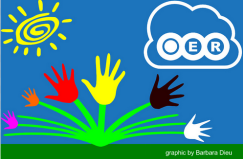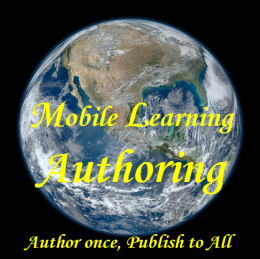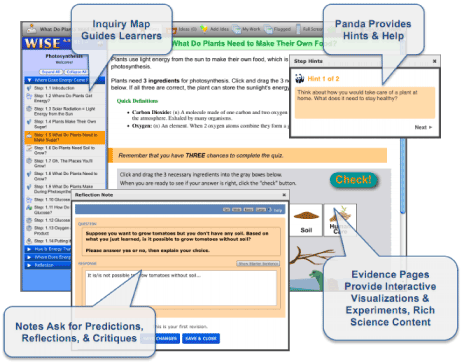Supported by the National Science Foundation, Web-based Inquiry Science Environment (WISE) is a free, online platform that engages students in the methods of real scientists and collaborative exploration of science issues through customizable curriculum and activities. Featured by Edutopia Technology Integration Research: Evidence-Based Programs by Subject :
WISE has been shown to improve students’ science achievement, especially when teachers customize WISE activities (Gerard, Varma, Corliss, and Linn, 2011). Researchers recommend that teachers customize WISE activities by using evidence from student work and teaching experiences to identify effective practices and then integrate these effective practices into future instruction (Gerard et al., 2011). Educators can browse WISE projects by topic (grade levels are indicated) and customize them via the Idea Manager tool. Teachers can also share projects with members of the WISE community. In addition to developing understanding of science practice, WISE discussions help students to develop skills in science argumentation and collaborative research.
Technology Enhanced Learning in Science (TELS) Community
Emerging from research collaborations started over 20 years ago, the WISE Community develops instructional programs that use educational technology to help middle school and high school students master complex scientific concepts. This community consists of partnerships between teachers, educational researchers, practicing scientists, and technology experts. WISE projects and software are developed by researchers in the Technology Enhanced Learning in Science (TELS) Community. The TELS Community includes partners at thirteen universities, a nonprofit educational research and development organization, and fifteen school districts. Local WISE teachers collaborate on research projects by providing their practitioner’s perspective during annual summer retreats and teacher interviews.
Proven Learning Gain
Since 1997, WISE has served a growing community of more than 15,000 science teachers, researchers, and curriculum designers, as well as over 100,000 K-12 students around the world. WISE curricula have been tested in middle and high school classrooms for over two decades in more than ten school districts. Prior research has shown that WISE curriculum units improve student learning of difficult standards-based science topics (Linn et al., 2006) and that students continue to integrate their ideas and strengthen their understanding even after the units have been completed. For more information about WISE learning results, visit the TELS publications database.
WISE Features
WISE combines a student learning environment and project authoring tool with the portal (user management, content management, course management) to create an inquiry-based learning management system.
WISE4 is free for anyone to use. WISE software is released under the GNU General Public License (see https://github.com/WISE-Community). On Jan.28, 2013, a stable version of WISE v4.6 was just released for download from http://wise4.org/. Related documents are :
- Features of WISE4 (downloads a PDF)
- Instructions for installing and updating WISE4 can be found here (stable deployment model) and here (latest deployment model)
- Developer Documentation (javadoc, jsDoc) can be found here
The main features of the WISE Virtual Learning Environment are:
Reading & Writing Prompts
- Predict, Observe, Explain, Reflect: The POER pattern guides students’ interpretation of text. Students write and justify predictions, describe observations of data collected, and use evidence to explain changes to their predictions.
- Critique & Feedback: Students develop criteria to evaluate divergent claims in terms style, purpose, and sources of evidence. Based on these criteria, they write critical responses to the work of their peers.
- Science Narratives: Students write coherent narratives that require them to select key events, and to attend to their order and coherence.
- Challenge Questions: Students evaluate the quality of different scientific explanations and are automatically redirected to relevant activities to improve their understanding.
Argument Organizers & Explanation Generation Tools
- Idea Manager: A graphic organizer that guides evaluation of evidence in terms of content, source, and connection to claims. The Idea Basket provides a persistent space for students to collect and sort multimedia information. The Explanation Builder provides an organizing space that scaffolds argument formulation using evidence in their Idea Basket.
- WISE Draw & Flipbook Animator: Students create drawings, take snapshots to create animation frames, and play back their flipbook-style animations. In doing so, students are guided to translate their arguments into different representational forms.
- MySystem: A diagramming tool to visualize sequences of events, and guide the writing of verbal narratives. Translating between different representational forms helps students recognize both the abstract structure of narrative, as well as the key content details.
Activity Templates
- Inquiry & Role-Play: WISE projects investigate personally meaningful driving questions. Students take on roles of scientists to investigate compelling phenomena, helping students to view science as accessible, which can enhance their motivation to achieve.
- Peer Critique & Feedback: Students are anonymously assigned work from their peers to analyze and critique. Practice generating criteria and giving feedback on other’s work helps develop critical evaluation skills, as well as collaborative knowledge building.
- Debate, Brainstorm, Discussion: Students share written explanations and feedback with their peers. They are encouraged to elaborate and build upon one another’s ideas.
Rich Media & Interactive Simulations
- Virtual Experiments: Similar to the activities of professional scientists, students plan and conduct experiments and gather data to support their claims. Prompts and graphic organizers scaffold students’ interactions with rich simulations and models of complex scientific phenomena.
- Multimedia Texts: Curriculum designers can customize and embed media-rich artifacts relevant to the target content in each project (e.g. animations, images, diagrams, graphs, videos, external webpages, and narrative text). Supported by scaffolding tools, students gain fluency in abstracting information from various representational forms.
Are you new to WISE? Register a free account now on http://wise.berkeley.edu.
Related articles
- A Classroom Framed by The Sky, The Earth, and Everything in Between (classroom-aid.com)











Your thoughts?